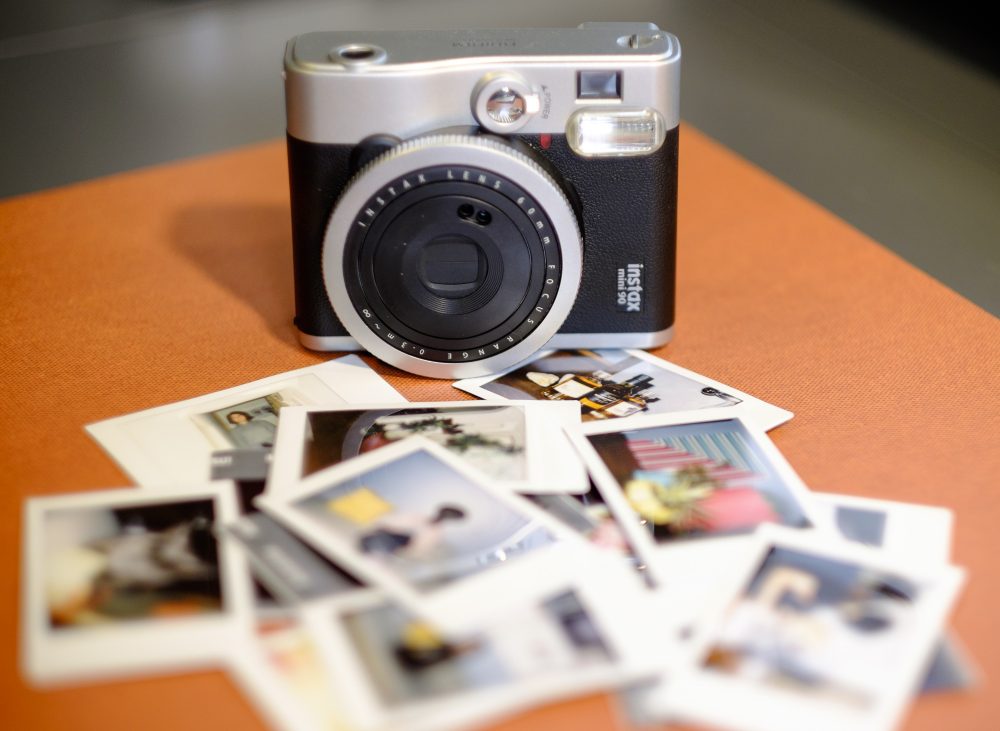The return of the instant film camera
By Maire Clayton
College students are known for hoarding books, alcohol, and ramen noodles. Recently, a blast from the past has flooded into college dorms.
Instant film cameras have found a new home among the young generation.
Though smartphones have dominated the amateur photography industry, the old-fashioned technology has rebounded.
Instant film photography, which was made famous by Polaroid, has carved out a niche as an artsy and fun pastime.
Caroline Link, a sophomore at Bryn Mawr College, loves instant cameras. On the weekends, she often uses a small Fujifim instant camera with her friends at parties. “There really cool and only artsy people do them,” said Link. “I have only ever used them with my friends.”

Instax Mini 90
“I know people’s angles!” exclaimed Link. “I have an eye for what looks good and what looks unappealing.”
Link believes instant cameras are definitely making a comeback. Almost everyone she knows has one or is about to get one. Link believes instant film is coming back because it is a great way to mark memories with friends.
Fujifilm is currently one the most popular brands of instant cameras. Unlike classic Polaroid devices, Fujifilm offers small, easy to use cameras. Fujifilm offers a wide variety of appealing colors and designs.
According to the Wall Street Journal, 100,000 Fujifilm cameras were sold in 2004. Sales rose to over five million in 2015. Fujifilm instant cameras outsold digital cameras by over 250% the same year.
Fujifilm instant cameras can be found at Wal-Mart, Target, and Urban Outfitters, among other retail stores. In each Urban Outfitters store, there is a section devoted to instant cameras. They sell many different types of cameras, film in black and white or in color, and a wide variety of frames.
The old fashioned feeling is what draws many to it. Not knowing how the photograph will turn out brings an added level of excitement.
“It’s not as immediate as traditional selfie taking on smartphones”, said Link. “Its less feedback, it’s more, it makes you feel more old school.”
Unlike digital photography, instant film does not allow for post-shooting edits or filters. Lighting highly affects the composition.
“You do not get to edit it; it is just printed there,” added Link. “You can’t change it.”
Emma Hicks, a sophomore, seems to share the same thought. “It’s like a different way to take pictures,” Hicks. “It’s a retro way to take photographs.”
While Hicks does not currently own an instant camera, she hopes to soon get one.
Polaroid announced the end of instant film production in 2008. That is when The Impossible Project started. The Impossible Project bought the last Polaroid factory before it closed. Now, they are the only company making original format instant film, according to their website.
The Impossible Project had a 75% sales increase in the 18 to 25 demographic, according to a 2014 Guardian article.
Radhika Singh, class of ’19, believes instant cameras are coming back. “I feel like a lot of people in the sixties and seventies used it, and now a lot of younger generations are using it because it is trendy.”
Singh is a huge fan of instant cameras. “I think that they are really cool,” said Singh. “It is a trendy way of displaying memories and capturing the moment.”
Ever since Singh noticed this trend, she has wanted an instant camera. She plans to get one for the holidays. “Very soon, very soon,” said Singh.
Mai Hoang, class of ‘19, was using an instant camera before it became popular. For the last three years, Hoang has used her instax mini 90. She said, “I use them once in a while, whenever I go travel or during some special events.”
She fell in love with this form of photography after she saw her friends use it. “I was totally impressed by the fact that we could get the photos immediately,” said Hoang. “I had never seen such thing before!”
“Nowadays, people just use their phones and Facebook for photos,” said Hoang. “So taking Polaroid’s is a nice and cool way for keeping pictures.”
The instant film photography trend perhaps reflects a desire to return to the old days. Perhaps the college age generation prefers a physical photograph to a digital file. Though the trend has found its niche in the hipster alternative community, it has started making its way into the mainstream community. Time will tell whether instant film photography reclaims the amateur market or disappears from college campuses.
